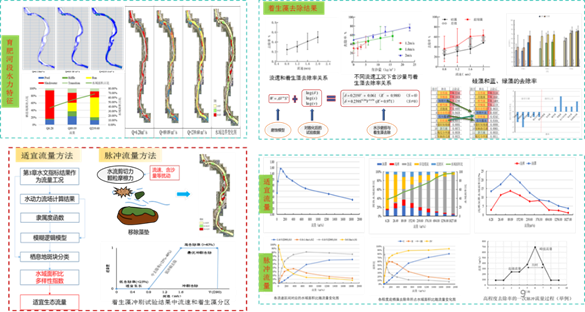Main Participants: BAIYIN Baoligao, CHEN Xingru, CUI Wei, CHEN Wenxue, LIU Feng, XU Fengran, MU Xiangpeng, WANG Xiuying, WANG Xingyong, LIU Hui
Regarding the negative ecological and environmental impacts brought by water projects and urbanization, such as severe water pollution, damaged aquatic ecosystems, the absence of aquatic landscape in urban rivers, etc., that hinder sustainable socioeconomic development and fail to the increasing demands of people for a better living environment, the research was carried out focusing on theories and applicable technologies for ecological restoration of urban rivers.
· Having explored the ecological, landscape, and cultural development theories and methods for comprehensive urban river management.
· Having analyzed the level changes and instantaneous flow rates of water with submerged flexible model plants and examined the flow resistance and flow structure of river channels with aquatic vegetation.
· Having explored the hydraulic characteristics of the new type of materials such as eco-bags, turf blankets, fish-nest bricks, etc. for building ecological bank revetment.
· Having probed into rainfall runoff patterns, pollution patterns, design methodologies for initial rainwater storage tanks, and critical technologies for water quality prediction and assurance.
· Having examined the velocity of ecological pulse for the scouring and replacement of perphytic algae in fish fattening farms and the ecological flows during fish fattening period in rivers.
· Having developed the indicators and evaluation criteria for urban river restoration featuring nature-based, prone to water and culture oriented, carried out research on integrated management of river systems, ecological restoration of rivers, ecological hydraulics, etc., and put forward the principles for integrated management emphasizing water quality as the key, ecological improvement as the foundation, beautiful landscapes as the profile, and cultural prosperity as the spirit.
· Having proposed for the first time a general empirical formula using the composite Manning’s roughness coefficient applicable to river channels with submerged flexible aquatic plants, which features clear physical parameter meanings and a practical, well-structured form.
· Having revealed the damage mechanisms, key influencing factors, and patterns of variation of innovative embankment protection materials, identified the application scope for ecological embankment materials, and clarified the flow field features and habitat suitability of fish-nest bricks.
· Having created an effective mathematical model for estimating pollution loads from event-based rainfall runoff, which features low data requirements and high estimation accuracy and are applicable to various regions. This has led to the development of five improved design methods for initial rainwater storage tanks based on various application scenarios, targets and sewage interception effects, all superior to current standards in China.
· Having elucidated the response of the removal rate of benthic algae, which is essential for fish fattening, to flow velocity and sediment concentration, established quantitative evaluation formulas for benthic algae removal rates by clear water and sediment-laden water flows, and identified the appropriate ecological flow for fish fattening periods and the appropriate ecological pulse flow for benthic algae replacement.
· The theories and methods for urban river restoration have been applied in nearly 20 provinces and cities across China, advancing the country’s ongoing research on integrated improvement of rivers. The research outcomes have supported the drafting of Beijing’s Guidelines for Comprehensive Management of Small-and-medium-sized Rivers (DB 11/T758-2010) and the Technical Guideline for Valuing River Ecosystem Services (T/SERB/001-2022).
· Research findings on the anti-erosion velocity thresholds of ecological slope protection materials have been incorporated into the Technical Specification for Application of Gabion Filled with Soil and Stone as well as Geo-bag for Revetment (CECS456:2016) and other specification, aiding the design, construction and acceptance of river ecological protection and restoration projects.
· Methods for delineating water ecological function zones on different scales and other outcomes have been applied to the development of water ecological civilization by the Department of Water Resources Management of China’s Ministry of Water Resources (MWR), the development of an integrated plan for the Luan River Basin by the Haihe River Water Conservancy Commission of the MWR, the management of small-and-medium-sized rivers in Harbin, water ecology protection and restoration of the Taipu River, the comprehensive management of the Yanhe River, etc.
· Approaches for calculating pollutant loads from surface runoff and designing initial rainwater storage tanks have been applied in Shenzhen’s efforts to ensure the water quality of the city’s Qinglinjing Reservoir.

Fig.1 Cases of river system planning and design in typical cities

Fig.2 Empirical formula with the composite Manning's roughness coefficient for river channels with submerged flexible plants

Fig.3 Model experiments and numerical simulation for ecological embankment materials

Fig.4 Research on ecological flows in rivers for conservation of critical species